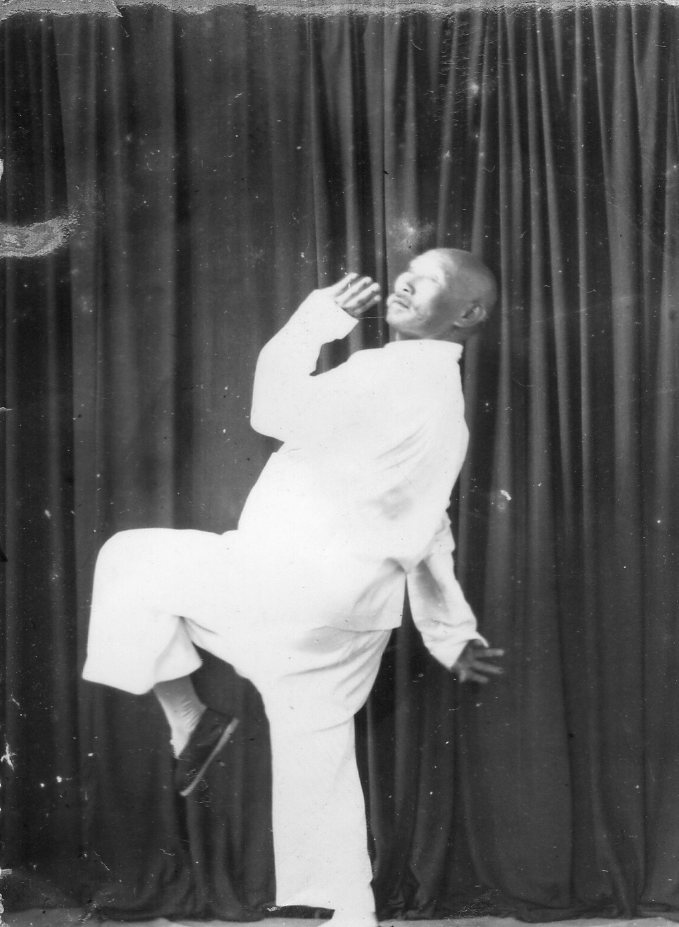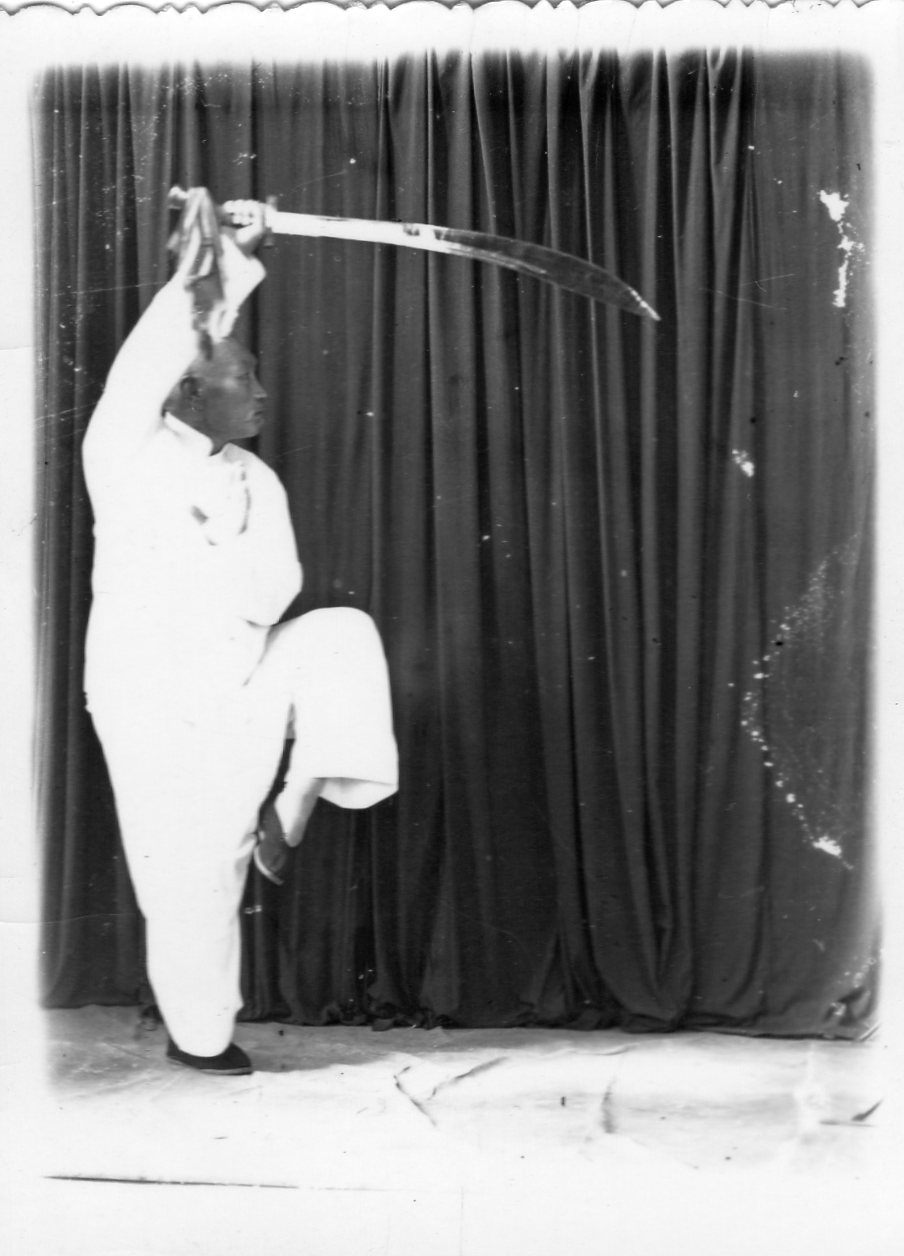

Fu Zhen Song
Fu Chen Sung was born in 1881 in Ma Po Village in the Sun Yan County of Honan Province. Ma Po village was close to the village of Chen Gar Kow, where Tai Chi was originally developed. The people of Ma Po village established a martial arts academy and hired two well known masters to teach there. Chen Yuen Shee of Chen style Tai Chi was one of them and Ga Fung Ming who taught Bak Gwa was the other. The young Fu Chen Sung trained hard under these two teachers. Later he had the opportunity to learn Bak Gwa from the great master Chen Ting Hua. He was taught without reservation by these men and made rapid progress over the years. He then travelled across China seeking other teachers and eventually become a bodyguard-cum-security man; a common undertaking by Kung Fu men of the time.
Many amazing stories have been told about Master Fu's fighting prowess. One day while returning to his village, Master Fu found that a Kung Fu master known as Tiger Yim was bullying the locals. Master Fu approached Yim to reason with him, but was forced to fight after diplomacy had failed. Master Fu easily defeated Yim and sent him flying. Shortly after, Yim returned with his four sons, armed with weapons. The first son attacked with a pole but Master Fu disarmed him and punished the other four attackers by injuring their feet.
On another occasion bandits surrounded the village. Master Fu charged out at them with his spear and killed dozens before the rest fled in terror. When more bandits took the village, Master Fu asked the leader to bring out his best twenty men. He made a bet with the leader that if he could defeat them then the rest of the bandits would withdraw; the bandit leader agreed. Using his famous "Hurricane Palm" technique, Master Fu trounced the lot of them and the village was saved.
In 1916, Fu was hired by General Lee King Lin ("Lee the God Sword"), who was a master of the Wudang school. A martial arts contest was held in the army barracks and after many fierce contests Fu was declared champion and promoted to platoon commander. General Lee's brother was a famous fighter named "Lee the God Spear"; he was said to be able to pin a fly to a pane of glass with his spear, without breaking it. Fu was challenged to a friendly bout by Spearman Lee and after a fierce encounter a draw was declared. The Lee brothers and Fu became close friends, often exchanging technical information.
Fu was hired as a head instructor of the Central Wushu Institute when it was founded in Nanking in 1928. A National Wushu tournament was organized. Wong Tak Yuan represented the Sichuan province and had defeated over 20 opponents. Wong's nickname was "Charging Fists" and he could smash rocks and mark iron with his hands. Fu, now aged fifty, was asked to fight him. After ninety rounds Fu defeated Wong. Later Master Fu took part in an exhibition of martial arts in the National Academy of Peking. In the latter part of 1928, five renowned northern masters were invited south. They were popularly known as the Five Northern Tigers. Master Fu, being one of them, went to Canton and took up a post at the Army Command HQ University Security Dept. When the Japanese captured Canton in 1938, Master Fu left the area and travelled around teaching the Chinese troops.
After the war, he returned to Canton and taught at the YMCA. At this time, Master Fu began to combine all his knowledge and developed the Fu style of Tai Chi. Fu style Tai Chi sword, Leung Yee (Harmonized Opposites Boxing), Bagua Dragon Palm, Weapons and many other forms. On the evening of April 26th 1953, the Stadium of Canton Cultural Park was packed and all roads leading to it were filled with people, streaming to see the famous Master Fu Chen Sung demonstrate the Bak Gwa Dragon Palm. Master Fu was called back for encore after encore by the cheering audience. Perhaps the strain of this experience and the prolonged efforts were too much for the old master, because five days later he passed away with inflammation of the brain.
Master Fu Chen Sung had four children; two sons Fu Wing Fei and Fu Wing Che, and two daughters Fu Qown Wou and Fu Mun Sou. His wife, Madam Ho, was also learned in Kung Fu. Master Fu Wing Fay became a worthy successor to his father. Because of his father's relationship to the Lee brothers he was able to inherit the Wudang system; he also mastered Yang style Tai Chi and many other styles. He divided the Fu style into three stages and the Wudang Sword techniques into five stages. He also improved the Tai Chi and Bagua systems of his father. He has held many prestigious posts in China including the Chairman of the Wushu Association of Canton Province.
His best known student in the West is Master Ken Chung of Vancouver, B.C. in Canada. Sifu Ken Chung studied with Master Fu Wing Fei for fifteen years, beginning his training at the age of 10. He assisted Master Fu with his teaching and training of his male students until he left China to move to Canada in 1980. He is presently teaching at the Vancouver Tai Chi Chuan Association.
Fu Style Tai Chi
Fu style Tai Chi Chuan is the proud masterwork of Master Fu Chen Sung, the father and teacher of my master, Fu Wing Fai. Fu style was developed from Yang style and all the major styles of Tai Chi Chuan, drawing from each style its best elements. The content of Fu style including hand techniques, body movements and footwork, are all more complicated than those in the Yang style and require more agility and nimbleness of movement. The style possesses some outstanding features as well as a sense of artistry. It is a comparatively difficult style to learn well, but brings benefits to the body and builds strength; therefore it is widely accepted by beginners as well as by advanced practitioners.
Fu style Tai Chi Chuan has proved to be one of China's excellent forms of pugilism. In recent years it has spread to many parts of the world such as Singapore, Hong Kong, Macao, Hawaii and Boston in the U.S.A. as well as to various places in Canada. It has gained acceptance from martial artists in the People's Republic of China as well as overseas.
Fu style Tai Chi possesses many qualities that the other styles lack. The opening and closing hand formations, the turning of the waist, and the foot techniques are unique characteristics of the Fu style. However with respect to its benefits and contributions, Fu style, like other Tai Chi styles, enhances the art of attack and defence, promotes good health, wards off illness and prolongs life.
Master Fu Wing Fai, after inheriting the legacy of the Fu style from his father, has studied and researched Fu style for over forty years. Having a deep passion for martial arts, he has never deviated from the basic principles of martial arts. Tai Chi has always been separated into three levels. Learning should progress from basic to advanced, from simple to complicated. Fu style likewise has three levels of achievement: beginner, intermediate, and advanced, and both male and female students have to pass these stages before entering the Wudang internal school of martial arts.
Wudang consists essentially of Tai Chi, Leung Yee, Sei Jiang, Bak Gwa Chang and the Dragon form, as well as broadsword, lance or spear, longsword, staff and forms of long fist. Because these are relatively difficult to master, a certain rigour and discipline is required and the student must have the perseverance, will power and stamina to complete the manoeuvres and forms.
The essence of Tai Chi is Yin and Yang. In the beginning Tai Chi requires the peacefulness and tranquillity of mind represented by Wu Ji, which is also the starting point of each action at each region: upper, middle, and lower. In each limb, movement represented by Tai Chi is germinated from lack of movement or Wu Ji. Every manoeuvre or step in Tai Chi incorporates as its basic principle the theory of Yin and Yang.
The foundation of each movement in Tai Chi is in the footwork: the forward step, the lift of the foot, the dropping of the foot and the shift of weight. All are exceedingly important. If one wants to learn Tai Chi well, first all the postures must be perfectly executed: light, loose and nimble; the stretches or extensions must be performed naturally and with ease and confidence. Of primary importance is perfecting the movements of the feet. The steps should be in precise multiples of 45 degrees (45, 90, 135) in order that the movements are unaffected and natural. The stability of the step has great impact on the perfection of style.
Secondly, one must pay attention to opening and closing, bending up and bending down, bending to the side, rotating the waist horizontally, left and right twisting of the waist, embracing and separating with the arms, turning and redirecting the opponent's force, pushing and pulling, rolling back horizontally, and moving the hands from side to side in cloud hands action.
There are the thirteen postures as well: ward off, roll-back, press, push, pull down, split, elbow, shoulder strike, advance, retreat, look to the left, gaze to the right, and maintain central equilibrium. Other requirements are: achieve tranquillity of mind and straightness of cervical vertebra and neck, relax the shoulders and lower the elbows, hollow the chest and round the back outwards, let the breath sink down into the dan tian, centre the coccyx in line with the spine, and distinguish clearly between empty and solid. The body is rooted through the feet and power is generated through the legs, the ruling force or originator of the movement is the waist, and the form is manifested through the hands. Each section is interconnected and performed without a break or slightest interruption. All of these are very important.
Fu style Tai Chi has some primary differences from other forms of Tai Chi in that other forms have a right form for many manoeuvres but not a left form. Fu style Tai Chi has right and left movements equally stressed. By performing the entire form, one can get a balanced exercise. The empty step is another unique characteristic of Fu style. The intended distinction of each posture is realized through internal power. Because of this, the entire body is energized. Each section is interrelated and connected and the range of movement and rotation of the fist and hips is relatively wide. In every turn and movement,softness must complement hardness. The body must be agile and skillful. Stretching and withdrawing must be performed freely, advance and retreat must be precisely executed. If the hips are loose, the steps can be quick and nimble. If the waist is loose, the movements of the upper body can cover a greater range. It can be seen that Fu style Tai Chi is a style worth promoting and is a style that is conducive to enhancing one's health and well-being.
Leung Yee Chuan
Leung Yee Chuan's original name was Tai Chi Fast Fist. It is the best style that the great wushu master Fu Chen Sung created.
In 1929, Master Fu Chen Sung, along with four other great masters from North China, moved to South China. People refer to this move as "Five Tigers Coming South". Fu Chen Sung took knowledge from various forms he had learnt and created Leung Yee Chuan. He travelled to outlying towns and villages teaching his form. Many people began to practise Leung Yee. His son, Fu Wing Fai, followed his father from childhood and is presently Canton's Wu Shu Association chairman. There are now thousands of people practising this form.
Leung Yee Chuan and Tai Chi Chuan are both internal styles of martial arts. Leung Yee Chuan's hand, body and step techniques are similar to Tai Chi Chuan's but the motions are all more complicated and require more skill. The self defence motions within it are more forceful and powerful.
The ability to learn Leung Yee Chuan requires a lot of physical exercise, technique development and focus. Leung Yee means two, two means balance. Yee means martial looking; it mean style.
Yi is the mind, yi must change agilely and quickly. The motions simultaneously follow the thoughts. The motions are forever changing. If the mind is slow, the motions are slow; the mind controls the motion. Fast and slow, up and down, forward and reverse, whether twisting downward or performing while jumping in the air, the style is natural and the motions are elegant, executed bravely with strength and focus.
Left and right balance and turning the waist is of the utmost importance in Leung Yee Chuan. The chi (breathing) comes up through the shoulders, down through the feet and legs. The legs and arms are the style, the focal point.
The body stays rounded throughout each motion. Open, close, up and down, front and back are all the same, the concept is to stay balanced. Inside and outside are very close. The flow of power is continuous. Body technique (waist, shoulders, hip), step technique and hand technique are all connected, enveloped as one.
Leung Yee Chuan has several main parts:
- Twisting and sweeping.
- Bending the waist down.
- Moving the waist forward and sideways.
- Turning using internal power.
- Jumping through the air using internal power.
Leung Yee Chuan's basic hand techniques, as well as incorporating the Tai Chi 13 main points, includes twisting palm left and right and spring punch.
The step techniques are forward step, reverse step, sweep technique, hook step, T-step, empty step, intricate turning steps, turn and sweep, big forward step, and short powerful steps.
Kick techniques are heel kick, straight kick, inside and outside circular kick, side kick, low straight kick and flick kick.
Body techniques include the 10 waist turns:
- Forward
- Backward
- Left sideways
- Right sideways
- Right turning waist
- Left turning waist
- Down turn left
- Up turn left
- Up turn right
Practise Leung Yee with the head suspended, shoulders and elbows down, chest bent and hollowed. The breathing goes to the solar plexus, the back is straight, and the weight distribution should be clear. Softness is a major factor in Leung Yee Chuan's motions, which are all executed with internal power.
Leung Yee Chuan introduces a new concept in the practise of sequential form. The waist leads the rest of the body through the weight changes and the step changes. The whole form's style is open but each movement is closed within itself. Twisting is very difficult. The motions also include rising and sinking, waist twisting, jumping and turning over. All the motions require skill and agility.
Leung Yee Chuan's motions are soft, the step is constantly changing and twisting as the motions change. It is good for the health and good for the body's equilibrium. Through practise, it can help many sicknesses. It regulates blood circulation adn enables you to feel the good it does inside your body. Leung Yee Chuan can help ease chronic illnesses.
The form contains long power, short power and inch power without much repetition.Through a lot of practise, Leung Yee Chuan will energize your body and mind and repeatedly restore your interest in learning this martial art. Many people like it. Whether you are young or old, weak or strong, you can learn and benefit from Leung Yee Chuan.

